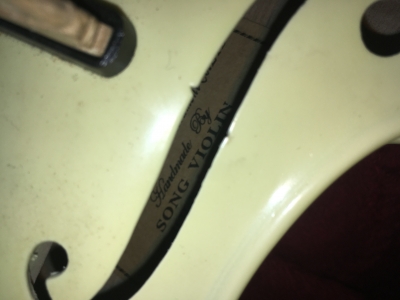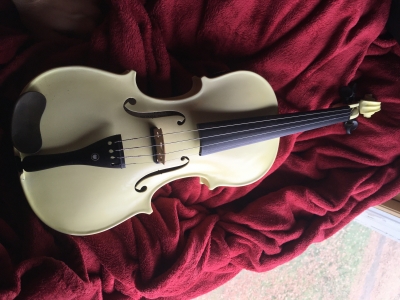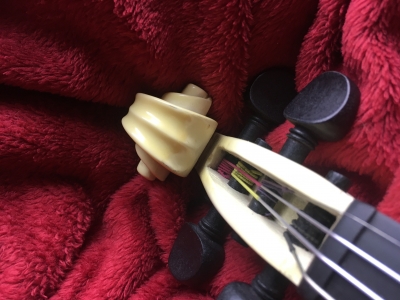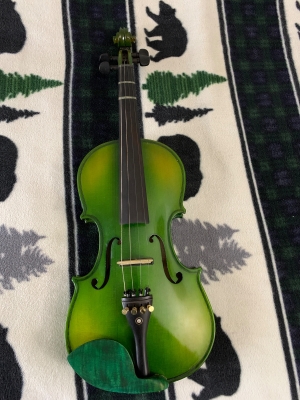Welcome to our forum. A Message To Our New and Prospective Members . Check out our Forum Rules. Lets keep this forum an enjoyable place to visit.
Currently working on errors from the latest (SimplePress) forum update. Many issues have been resoled and others are being worked on. Thank you for your patience.
 Topic RSS
Topic RSS



 (1 votes)
(1 votes)  Offline
Offline
Hello,
I have a chinese Violin that has a white spray on finish of some sort that is turning yellow. The kicker is this violin has had very little if any UV exposure so I have no idea what is causing this discolouration other than age. I really do like the sound of this violin but the appearance is really... something. When your family describes it as pee yellow you know it’s no longer looking anything like white.
thing is would it even be worth the attempt to try to remove this finish and give it something nicer? I honestly feel so bad for this violin as the wood under the finish appears to be lovely. You can even see bits of flame hiding under this god awful mess.
its not a valuable violin, that I know but it is my first violin and I really do like it’s sound. Despite the fact it starting to look like a Commodore 64.
Member
 Offline
OfflineYo Batto!
If you really think you want to attempt to refinish this instrument, you should be researching the various types of finishes that have been used in the past. I think you can find most of your information on the internet, with possible solutions to remove the old finish.
The one suggestion that I do have is to proceed carefully, whatever you do. I personally would not attempt to remove it with sandpaper or a scraper before finding the correct solvent to take off the finish. Based on your description, it could be any one of 4 or 5 possible finishes. I would start with lacquer thinner in a very small test area and see the effect of light rubbing with a clean cloth with a tiny bit of thinner.
I think it would be helpful if you took some close-up photos under good light and share them with us.
Plan B- if you really like the sound of this instrument, seriously consider leaving it alone- you may not be happy if the sound changes after restoration.
Good luck and keep us in the loop!
JohnBAngel

Regulars
 Offline
Offline








@Batto - Hi!
I haven't refinished a violin, but I have worked with many traditional and modern finishes/paint on hardwoods, metal and glass.
Yellowing is not an uncommon problem with many finishes.
You mention your violin hasn't been exposed to UV light and the finish has pigment (not clear). I have heard of some instances where actual exposure to light can possibly reverse the yellowing - at this point, what do you have to loose? I wouldn't recommend this if you have high humidity/heat where you live.
Here's a couple links for reference to get you started on your research until other members here on the forum can help you. 😁
- 4th post here is GREAT (Nestor Kelebay) - some archival info you may wish to further investigate, not just about polyurethane! https://handymanwire.com/ubbth.....lyurethane
- Chinese violins bought on ebay - One very interesting post by "Mikea" - "Varnish is hardly the correct word..." https://thesession.org Search in discussions for "Varnish removal".
- If you understand how much a wood finish can affect violin sound and you'd like a little understanding about traditional violin varnishes, here's a start. https://stringsmagazine.com/vi.....trength/
I am assuming you've looked through the threads here in this section of the Fiddlerman Forum and at least know how to handle things like your soundpost before you attempt to strip the finish?
Good Luck - can't wait to hear how you fair with this!
 - Emily
- Emily
Regulars
 Offline
Offline

@Batto and others. My minor experience with painted instruments (Cecilio electronic violin and cello) leads me to advise that they are not suited to refinishing. Paint is often used to hide workmanship blemishes repaired with filler.
You might be able to remove discolouration with a metal polish similar to semichrome or flitz.
A self levelling urethane paint, used in the boat industry, is somewhat expensive but does a great job for this type of work if polish alone is not successful.
Success is the progressive realisation of a worthy ideal. —Earl Nightingale.
 Offline
Offline








Getting accurate photos of this colour is hard with my phone (wonders if it’s triggering built in filters that adjust for people’s teeth to make them look whiter.)
This isn’t a Cecellio or such. It’s from Song Chung instruments I purchased this around 2013 in a bundle deal with another violin for 329$ directly from china. It’s not a VSO and even if the wood has mile defects It wouldn’t bother me. But from what I could see from the other violin I got ( I’ll have a friend take pictures of it since I sold it to him because of bad memories associated with it.) the wood actually is of nice quality.
but claims on the internet ad listening are just that, but even the set up wasn’t that far off. I replaced a few things on this that’s why it has painted fittings. But it stays in tune and the audio out is kinda nice.
I asked my friend for pictures of the pair violin and I’ll upload them.
 Offline
Offline



 For those curious for a read I have found an interesting article pertaining to 1700’s French violins and their varnishes.
For those curious for a read I have found an interesting article pertaining to 1700’s French violins and their varnishes.
https://stringsmagazine.com/a-.....o-varnish/
it actually includes some historical recipes.
my biggest worry in this endeavour is the concern of negatively affecting the hide glue of the violin if any solvent is used to remove the finish.
ah my friend just sent over the photos of my violin’s twin.
i hope the pictures of the other violin showcase why I am even contemplating stripping this one.
Regulars
 Offline
Offline








@Batto -
I have used a lot of Hide glue - granules soaked in water & heated.
It's organic & shouldn't be effected by solvents, but you never know what they add into stuff now-a-days.
Many people use "Liquid" Hide glue, today. They had to add something to make it shelf-stable, ammonium rhodanate; dicyanodiamide.
I think it would be smart to buy a bottle of Liquid "Titebond Hide Glue" (or equivalent), let it dry thoroughly on some scrap wood (maybe best with some finished/painted wood scrap) - then test with whatever solvent you plan to use on your violin.

- Emily
Btw, you might be able to get a better idea of the quality of the wood before you strip it, but you'd have to find a good way to see inside your violin (there's ways...).
Nice article - Thank you!
Regulars
 Offline
Offline








@Batto -
I can see your point - I really like the look of the green violin you sold.
Looking closer at your photos, the yellowing does not appear to be evenly distributed - like it's not a paint issue. Or, is it just the photo?
This may be an obvious question - has your violin been exposed to any nicotine or smoke in the house?
What products have you used to try to clean the yellowing on your violin?

- Emily
 Offline
Offline
ELCB said
@Batto -I can see your point - I really like the look of the green violin you sold.
Looking closer at your photos, the yellowing does not appear to be evenly distributed - like it's not a paint issue. Or, is it just the photo?
This may be an obvious question - has your violin been exposed to any nicotine or smoke in the house?
What products have you used to try to clean the yellowing on your violin?
- Emily
It’s not from nicotine or smoke it’s some sort of chemical reaction from the finish. Scrubbing it and washing it does nothing. It also hasn’t been exposed to anything like that. I literally have no clue what could be causing it other than some sort of oxidation reaction or perhaps even the paint reacting or leaching something from the wood. It’s a mystery to me. Also I do believe that this finish is muffling the violin.
Upon closer inspection it appears that this finish is a two stage paint job. I’m seeing slight metallic flake in it which really doesn’t show up, the yellowing seems to be in the thick clear cloat. But shining a light on this finish does reveal parts of the construction like the purfling.
another hint at it being the clearcoat that is the culprit is the fact that there’s white overspray/tape soak on the ebony fingerboard that hasn’t changed colour.
Member
 Offline
Offline@Batto
Based on your latest information, I believe you are dealing with one of two possible products:
1) Nitrocellulose lacquer
2) Pre-catalyzed lacquer
Paint stripper option: will do the job but will destroy anything plastic.
Lacquer thinner or acetone: apply and rub, repeat multiple times, be patient
Heat and scrape: not recommended due to the fragile nature of the wood.
Follow up with hand-sanding starting with 220 grit or higher. Avoid using wet-sanding techniques, water is your enemy here.
Anything you do will be slow and tedious- proceed with care.
Good luck- let us know how it turns out.
JohnBAngel

1 Guest(s)


 Log In
Log In Register
Register





















